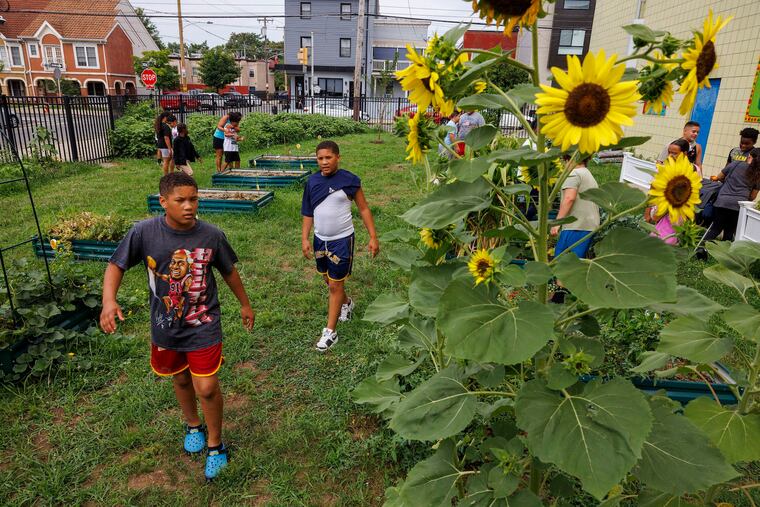At this Kensington elementary school, a garden grows for all
Hunter Elementary has a new gardening elective, new for a Philadelphia School District K-8. Every school needs something to cultivate, the gardening teacher believes.

School is out for the summer, but Aileene Halligan Cantiello’s classroom in Kensington is full-to-bursting with watermelons and tomatoes, collard greens and black-eyed peas, sunflowers, asters, and a dozen kids.
The children showed up for a voluntary harvesting session at Hunter Elementary School’s garden because, as rising sixth grader Willie Ramos said, “it’s such a satisfying feeling to pop a tomato out of the ground.”
Hunter launched a gardening elective last year, unique for a Philadelphia School District K-8. The neighborhood surrounding Hunter has made international headlines for its drug trade, poverty, and crime, but the garden brings something hopeful to the corner of York and Howard, where the El routinely rumbles by overhead.
“A garden is an antidote to all that,” said Halligan Cantiello, a master gardener. “When you see a garden, you see safety, you see abundance, and you see community care.”
Gardening for all
Heather Mull Miller, Hunter’s principal, has big ideas for the school. So when she reconnected with Halligan Cantiello, a former coworker at Kensington High School, she pitched the garden idea.
Halligan Cantiello had been out of the classroom for a few years, but was looking to return. What if she created both a course and a garden from scratch, Mull Miller asked? (The school had a handful of raised beds and a big patch of unused grass.)
It didn’t take much convincing.
In the past decade, Halligan Cantiello has embraced gardening enthusiastically, and the more she did, the more she thought: Every school needs something to cultivate.
“This is an outdoor classroom where students can dynamically take all the skills they learn and apply them to solve real problems,” Halligan Cantiello said. “I don’t announce that we’re coming out here to do math, but I say, we’re being gifted 500 native flowers. Each one needs one square foot of growing space. We need to map out a perimeter today to accommodate that — how are we going to calculate it?”
The garden hasn’t taxed Hunter’s budget much, because Halligan Cantiello has received a number of grants that meant free equipment and money.
Each of the 380 students at the school participates — the kindergarteners, the trying-to-be-cool eighth graders, the students with disabilities (there’s a wheelchair-accessible garden bed), the English language learners.
When the weather didn’t cooperate, lessons were inside, in a dedicated classroom with a hydroponic setup, but the kids also gardened outside with snow on the ground, bundled up in hats and coats. At the Hunter school store, life skills students sold produce and herbs from the garden on Fresh Farm Fridays.
‘It’s very nature-y’
Less than a year since the first seeds went in the ground, the garden is lush. Cheerful art frames the space. Colorful paintings of fruit and vegetables hang on the school wall just past the 12 raised beds.
Students talk casually about hand-pollinating corn, remove weeds without complaining, and identify plants easily, marveling at their textures, smells, and tastes.
There’s been a learning curve for everyone, to be sure. Hakeem Dallas, who will be in sixth grade, was hoping to see (and eat) more Hunter strawberries, he told Halligan Cantiello on Thursday.
“The strawberries have been really battling the heat,” the teacher told Hakeem, 11. “I think we needed to plant them earlier.”
Later, in the pollinator patch, Halligan Cantiello pointed to a slender, fuzzy plant and frowned.
“These are cattails,” she said. “They’re cool, but we didn’t plant them, so take them out.”
A group of young people set to work pulling out cattails and other unwanted greenery.
There are garden rules: no running, no horseplay, no squirting anyone with water from the hose, use tools carefully.
But Halligan Cantiello needed to do little reminding; her students seemed delighted just to have their hands in the soil again.
Sianie Rivera, who will be in fourth grade in the fall, said she loves the garden.
“I like how it’s very nature-y,” said Rivera, as a car drove by, music blaring. “It calms you down. Nobody would expect to have a gardening class here, but it’s honestly very nice.”
Mateo Matos, who just finished kindergarten, considered himself to be an expert gardener now.
“I eat everything,” said Mateo, 6. “And my name rhymes with tomato.”
Minutes after students harvested dozens of ripe tomatoes, Halligan Cantiello sliced them into quarters and passed them around. She had plenty of takers.
“They’re so sweet!” one student shouted.
A bumper crop
The yield has been more than just tomatoes and watermelons.
There’s enormous value, Mull Miller said, in the relationships the garden is helping to build — people see what’s going on and want to help, like the crossing guard who liked what she saw and donated equipment. (She loves the garden’s collard greens.)
The principal envisions more opportunities for families to engage: summer watering sessions, gatherings for parents to come and learn about the math curriculum and snack on food grown by their children.
Many Kensington families “have a broken relationship with school,” Mull Miller said. The garden is one step on the way to repair that, to offer families something positive.
“We’re trying to make school so much more than reading and math,” she said. “This is a thing that kids like to do, that gets them to come to school. I’m constantly looking for opportunities for my kids.”